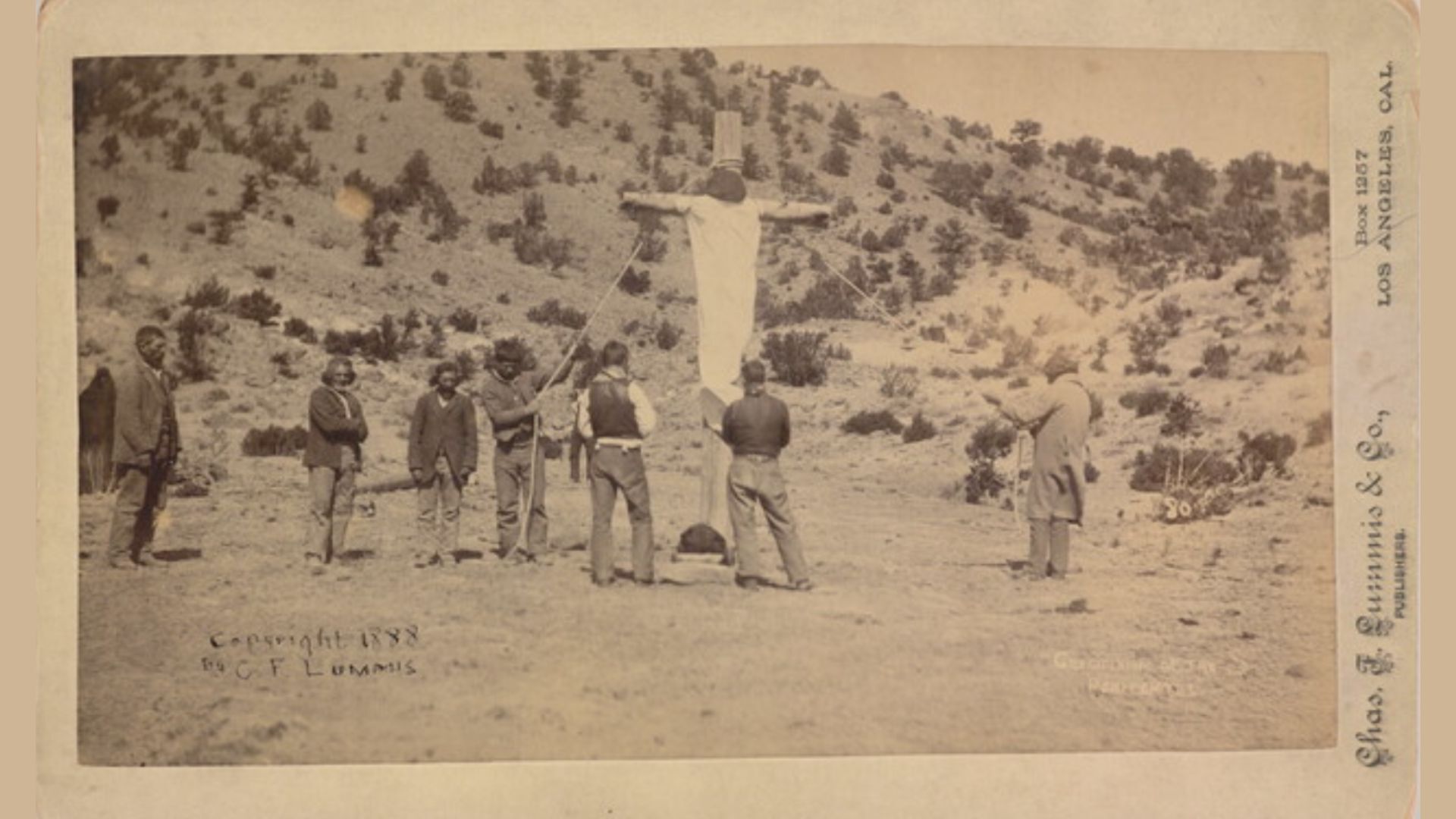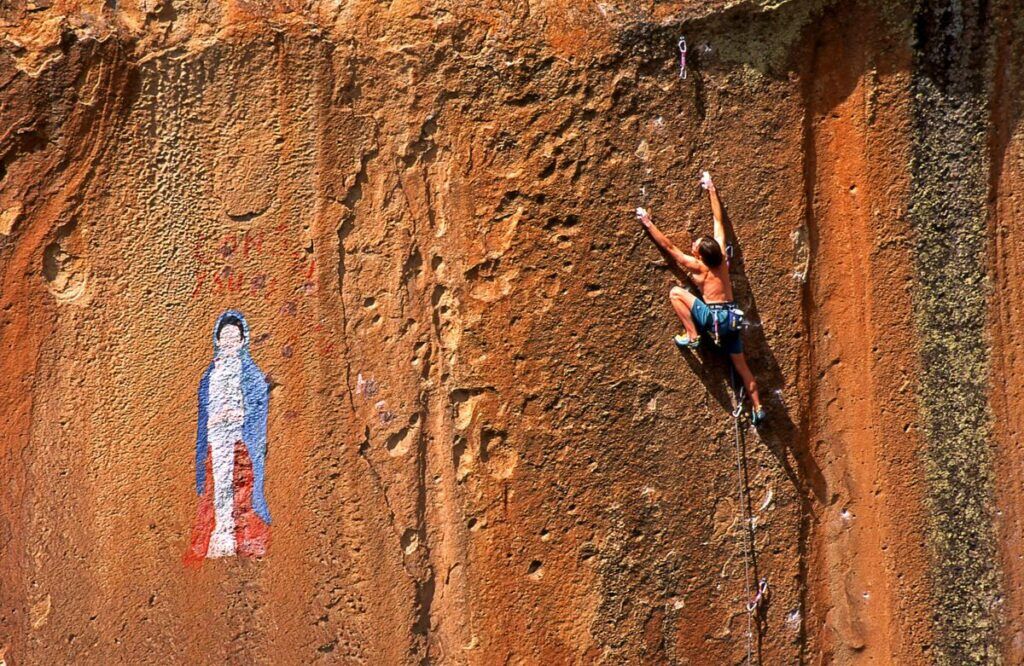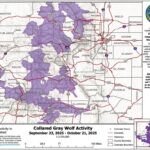Ritualistic crucifixions may have occurred in scenic Colorado canyon

While a certain southern Colorado destination is best known for its rock climbing and camping, visitors will have a hard time missing a large mural of what appears to be that of an angel painted high on a prominent rock face.
An eerie sight in an otherwise natural space, the mural is no angel, but a depiction of the Virgin of Guadalupe – the mother of Jesus, added to the canyon sometime in the 1980s by artists rumored to be descendants of members of a mysterious religious group that sought refuge in the remote area, presumably while practicing self-flagellation and crucifixions. Welcome to the remote Penitente Canyon of Colorado’s San Luis Valley.

According to reporting from local news source The Crestone Eagle, Los Hermanos Penitentes first gathered in the canyon in the late-1800s to conduct secret religious meetings that involved the practice of “radical rituals.” Considering that the group was a non-traditional sect of Catholicism, the Los Hermanos Penitentes were pushed underground and reportedly sought refuge among the canyon walls.
This move into secrecy is said to have followed the rise of the group in the eighteen and nineteenth centuries, with the decline of Spanish missions in the American southwest said to be a factor. Granted not a lot is known about the group, as members could reportedly be punished for revealing information.
“Outsiders saw Penitentes as a secretive cult employing deviant practices,” reads a description of the public’s perception of the group that’s published on the Denver Public Library website.
The same article provides insight into what some of these practices were: “During Holy Week, they publicly whipped themselves with Disciplinas, whips made from Yucca stalks. They bound bundles of cacti to their bare backs or were bound to heavy wooden crosses as they walked through the Stations of the Cross. As for rituals that went on behind closed doors, a novice received three Ave Maria cuts on his back to show that he was a genuine Penitente. A man who had wronged his family, community or fellow Penitentes might receive a flogging or be made to crawl back and forth with bare hands and knees on pebbles and stones.”
At least one image of the group allegedly conducting their unorthodox practices exists, captured by Charles F. Lummis in 1888 and appearing to show the reenacted crucifixion of Jesus Christ.
The following lines are written in cursive on the back of the antique photo: “This picture represents the actual crucifixion of one of the ‘Penitentes.’ The authorities try to stop these barbarous religious (?) ceremonies but not with entire success. The negative from which this was taken is the first even obtained, and it was done then at the risk of the life of the photographer.”
The description of the photo continues with printed text:
“A brotherhood of religious fanatics, of great antiquity, who still practice their barbarous rites in New Mexico. During Lent they carry huge crosses, lash their bare backs with terrible whips, lie or crawl on beds of cactus; and wind up on Good Friday by the actual crucifixion of one of their number, chosen by lot . There were once many thousand in New Mexico, but now their rites are observed in but two or three hamlets.”
Allegedly, one of those hamlets may have been located in southern Colorado’s Penitente Canyon.
Over the years, whether or not the rumors are true that the Los Hermanos Penitentes claimed the Penitente Canyon as a place for secret gatherings has been drawn into question. Not much hard evidence of these practices taking place at that specific spot seems to exist.
According to a 2022 piece from Taos News, the group is still active in the modern era, “centered around community and penance, a Catholic sacrament involving the confession of sin, self-punishment and forgiveness.” A statement from Del Norte Trails Organization adds to that, noting that the religion is now considered free to practice in public and that it’s even celebrated in the town of Taos, New Mexico.
It’s also worth noting that The Crestone Eagle has reported that Penitente Canyon may still serve a role related to the group today: “While the curious ceremonies and rituals of this sect dissolved over time, rumors suggest that descendants of Los Hermanos still visit the canyon today, making it a place of continued cultural and spiritual significance.”
That being said, the only obvious reminder of the possible Los Hermanos Penitentes’ presence in Colorado’s Penitente Canyon is the large mural added to the rock face years after the group was practicing rituals at the spot and apparent wagon ruts that still exist.
Most visitors to the canyon in the modern era have absolutely no tie to any sort of secret religious group, instead visiting the stunning destination to rock climb or explore trails.
Learn more about outdoor recreation opportunities that exist at Penitente Canyon here.
STAY INFORMED: Get free Colorado news with our daily newsletter (Click here)
Get OutThere
Signup today for free and be the first to get notified on new updates.






